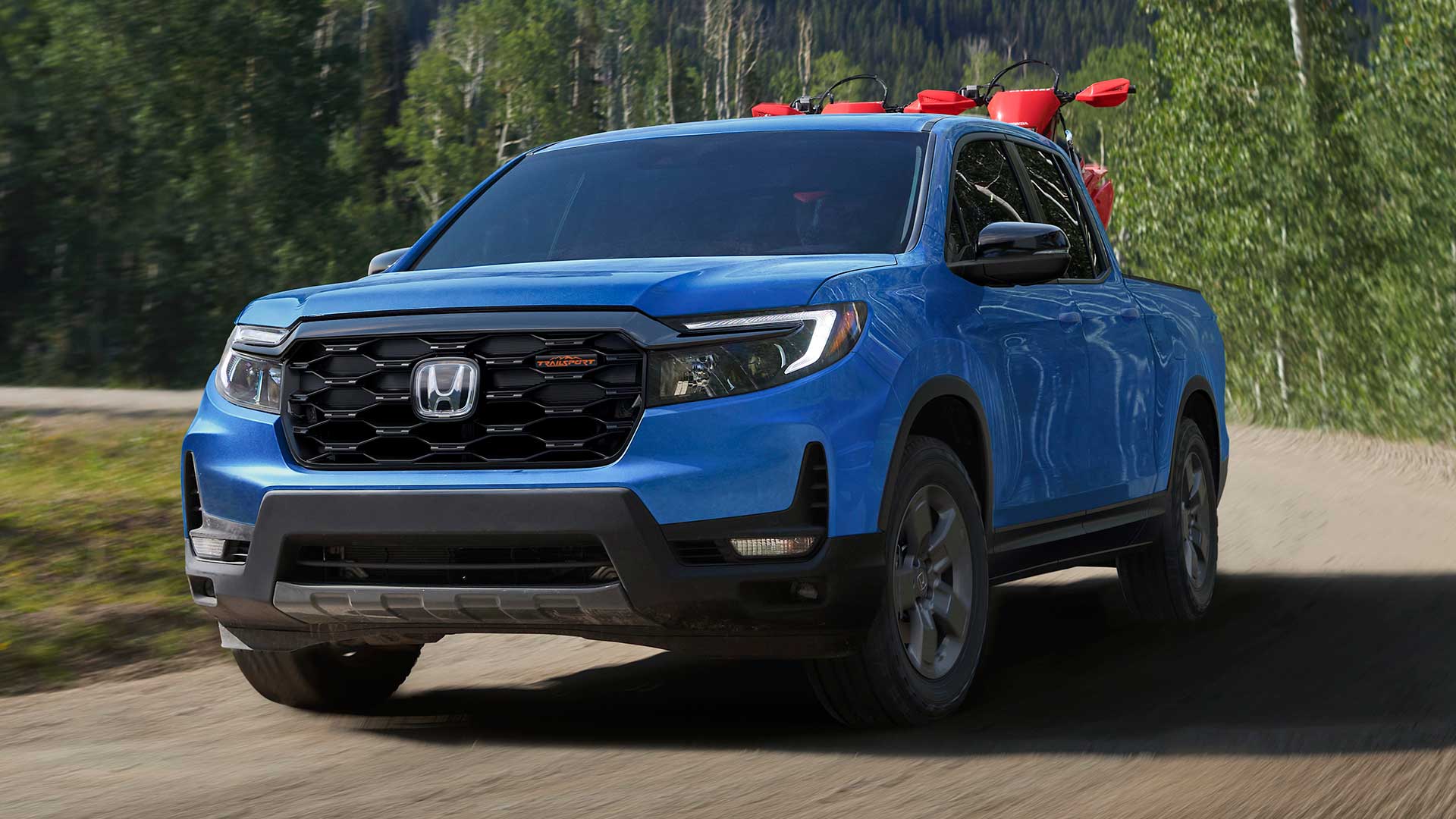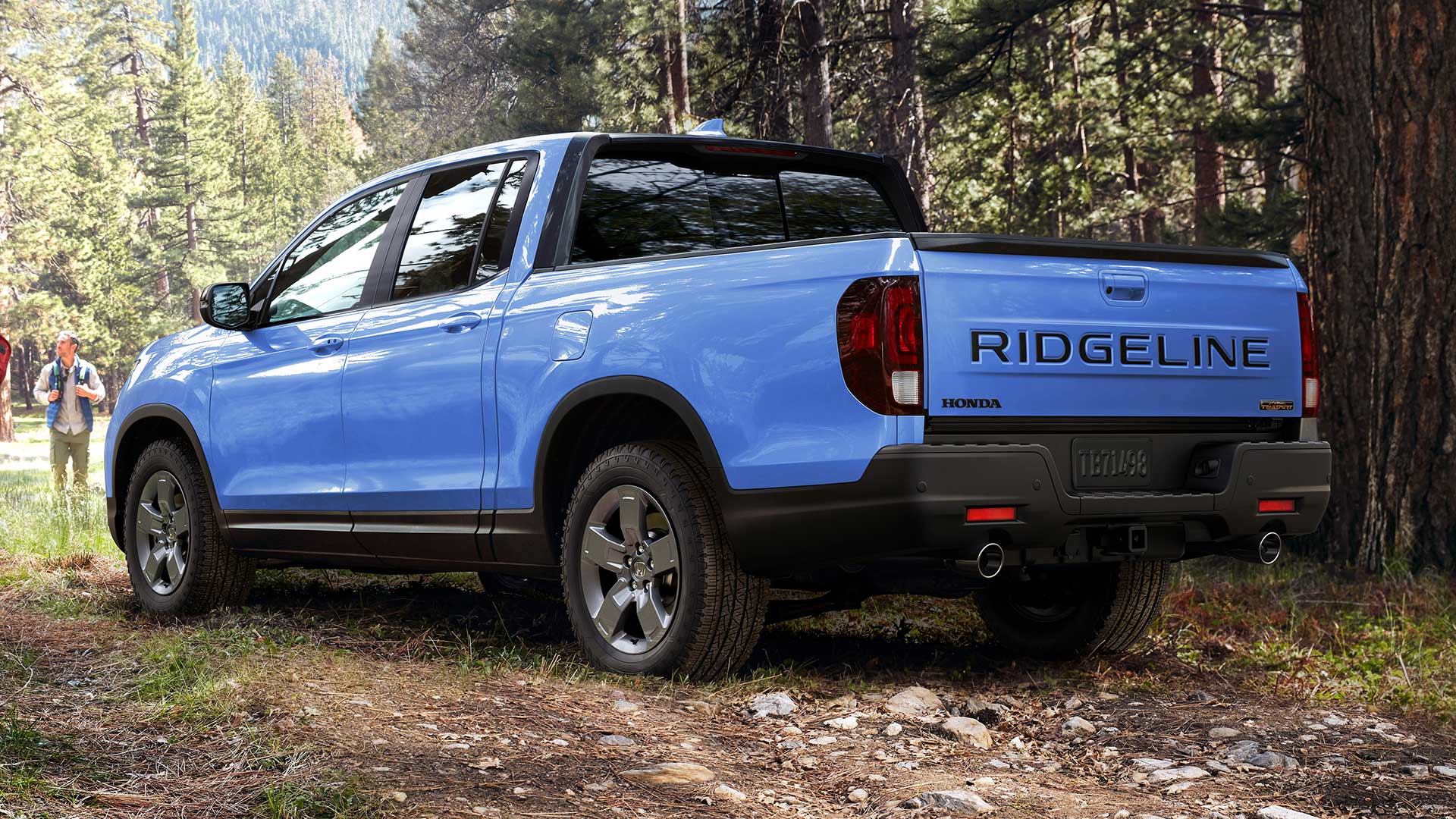2014 Audi RS7
In the rarified world of ultra-high performance Audis, many think the exotic R8 is the champ. But it’s actually the 5-door RS 7 that is the most powerful Audi sold here. That’s right…you don’t need supercar style or impracticality for serious, street-fighting, track melting capabilities. Too good to be true? Well, buckle up!
It took us no time at all to absolutely fall in love with the Audi RS 5 when we hit the track with it last year. But to be honest, that car pales in comparison to this car, the 2014 Audi RS 7.
Building on the far from pedestrian S7, Audi pumps up the performance in just about every area of this vehicle.
Weight has been shaved by 30-pounds. And there’s more power, thanks to Audi cranking up the boost in the twin-turbo 4.0-liter V8 to 17.4 psi. That makes for 560-horsepower and 516 lb-ft. of torque. Quattro all-wheel-drive, along with the S7’s sport differential, and air suspension, are all standard.
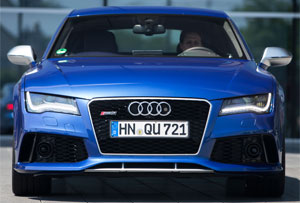 One thing that hasn’t changed, is that much like the S7, this car seems up for just about anything you can throw at it; feeling smooth and steady no matter the speed. Compared to the impressive S7, it cuts through the cones even more effortlessly. Dynamic driving mode keeps the body roll well under control, but doesn’t necessarily make it feel more responsive.
One thing that hasn’t changed, is that much like the S7, this car seems up for just about anything you can throw at it; feeling smooth and steady no matter the speed. Compared to the impressive S7, it cuts through the cones even more effortlessly. Dynamic driving mode keeps the body roll well under control, but doesn’t necessarily make it feel more responsive.
However, the electromechanical steering is insanely quick on turn-in with a precise, heavy weight, but unsurprisingly little feel. More would be hugely welcomed. The upgraded brakes are great for such a heavy car, but not quite in supercar territory with average stops of 117 feet from 60.
Acceleration, however, is glorious, as there is a ridiculous amount of torque and quattro traction propelling you on an 11.7-second adrenaline rush through the quarter-mile at 123 miles-per-hour. The transmission is a straight-up 8-speed Tiptronic automatic, not a DSG, but it works better than most dual clutch boxes, so we have no complaints.
The first two gears seem ultra-low…that’s for acceleration, getting you to 60 in just 3.6-seconds while the top gears go into extreme overdrive. Manual shifting is hard to get just right on the power sweet spots, so just let the computers and accelerometers do their thing and propel you to glory.
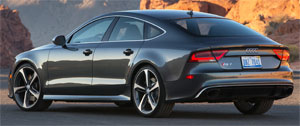 Now if you’re on the highway and you choose to nail the throttle to its fullest, make sure you’re not even close to someone’s bumper, or you’ll be in it in no time as this thing just flat take off. So, it’s quicker than a BMW M6 Gran Coupe, but not quite as fast as the Mercedes-Benz CLS63 AMG. But perhaps more importantly, thanks to cylinder deactivation among other things, it out fuel misers both of them.
Now if you’re on the highway and you choose to nail the throttle to its fullest, make sure you’re not even close to someone’s bumper, or you’ll be in it in no time as this thing just flat take off. So, it’s quicker than a BMW M6 Gran Coupe, but not quite as fast as the Mercedes-Benz CLS63 AMG. But perhaps more importantly, thanks to cylinder deactivation among other things, it out fuel misers both of them.
Government Fuel Economy Ratings are 16-City, 27-Highway, and 19-Combined. So, our average of 22.1 miles-per-gallon of Premium is quite good for supercar-like performance.
This vehicle is clearly made for eating up mass quantities of Autobahn miles at thrilling speeds in extreme serenity, as Audi seems to be in competition with themselves on building the most amazing interiors. No one else is really even in the game, as here the custom-crafted environment gets even better.
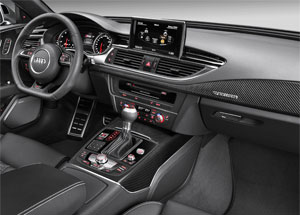 It looks and feels like those super expensive pieces of custom luggage you see that cost well into 5-figures. RS extras include shifter, steering wheel, carbon-fiber trim, unique door handles, and instrument panel.
It looks and feels like those super expensive pieces of custom luggage you see that cost well into 5-figures. RS extras include shifter, steering wheel, carbon-fiber trim, unique door handles, and instrument panel.
Front seats are just great, very racy feeling yet also luxurious to the hilt. While it doesn’t feel, or look particularly big, ease into the rear seats and the car feels huge.
Instead of a one size fits all approach to the exterior design, buyers can opt for standard, matte aluminum, or carbon styling. This example sports the matte aluminum look along with new bumpers, revised Singleframe grille, adaptive rear spoiler, lower diffuser, and big elliptical taillight tips for the highly recommended optional sport exhaust system. Full LED lighting is standard.
But let’s be honest. At $105,795, the $25,000 price leap over an S7 may purely be for bragging rights. Most owners will never experience the full potential of this car. We really don’t have the appropriate roads in North America to fully exploit the RS 7’s capabilities. You do need the German Autobahn, or at least, your own track day for that.
We thought the S7 was terrific. But in creating the 2014 RS 7, the otherworldly Audi engineers are again on point. Too good to be true? Not hardly. Overkill? You’re darn right!
Specifications
- Engine: 4.0-liter V8
- Horsepower: 560
- Torque: 516 lb-ft.
- 0-60 mph: 3.6 seconds
- 1/4 mile: 11.7 seconds @ 123 mph
- EPA: 16 mpg city/ 27 mpg highway
2024 Honda Ridgeline TrailSport
It Does Truck-Like Things Better Than Ever
Honda brought something truly unique to the pickup truck scene when their mid-size Ridgeline debuted for 2006. In 2017, it moved towards becoming a little more true truck-like, both in form and capability, now with yet another step in that direction for 2024. So, let’s see if the Ridgeline is really hitting its stride.
For 2024, it’s all about making this Honda Ridgeline better than ever. There are styling tweaks outside, along with tech and functional improvements inside, but the biggest news is the Ridgeline has now joined Honda’s TrailSport family of off-road inspired vehicles. This more-true-trucklike, second-gen Ridgeline been around since 2017, receiving periodic updates over the years; but joining the TrailSport family is the biggest leap yet.
Primarily, the TrailSport transformation includes General Grabber all-terrain tires, mounted on new Pewter Gray 18-inch wheels, steel underbody protection, and retuning the strut front, and multi-link rear suspension for added wheel articulation. And while we always appreciate the additional traction of off-road tires, the Ridgeline’s standard i-VTM4 all-wheel drive, with Intelligent Traction Management and snow, sand, and mud settings, was already quite capable of handling all but the most extreme off-roading, ground clearance of just 7.6 inches being it’s only real hinderance.
A 3.5-liter V6 remains under the hood as it has since the Ridgeline debuted for 2006; the current version outputs 280 horsepower and 262 lb-ft of torque, plenty enough muscle to handle its 5,000-lbs. towing capacity. A nine-speed automatic transmission with paddle shifters and bevy of push and pull buttons on the console replaced the six-speed automatic back in 2020.
In addition to adding TrailSport capability, a big focus for this update was making it more user-friendly inside, starting with the central touchscreen growing from 8 to 9 inches. It also gets faster processing speeds, menus have been simplified, and the native navigation system is improved with better graphics. It’s accompanied by a new digital instrument cluster, along with an upgraded center console with more storage space. Unique TrailSport touches include heavy duty floormats, leather-trimmed seats, orange stitching throughout the cabin, and orange ambient lighting.
The Ridgeline continues to offer things available nowhere else in the pickup truck market.
Exterior styling doesn’t exactly shout “macho big rig coming your way,” but the more vertical face and larger grille that arrived for 2021, along with this year’s added TrailSport elements, do continue to toughen up the Ridgeline’s image. The 5’4” bed remains highly functional with no large wheel well intrusions, multiple tie-downs points, lighting and even speakers. And of course, the Ridgeline continues to offer things available nowhere else in the pickup truck market, like the dual-action tailgate, and large, lockable, drainable, underbed storage. Not to mention being able to drive around in true car-like comfort, something we took full advantage of on our way to our Mason Dixon Dragway test track.
There was great grip off the line, with full power arriving smoothly but quickly, helping us to get to 60 in 7.0 seconds flat, a tenth quicker than the last Ridgeline we tested. That power delivery stayed fairly consistent the whole way down the track, barely interrupted by the nine-speed automatic’s smooth shifting. Our best quarter-mile run was 15.5 seconds at 90 mph.
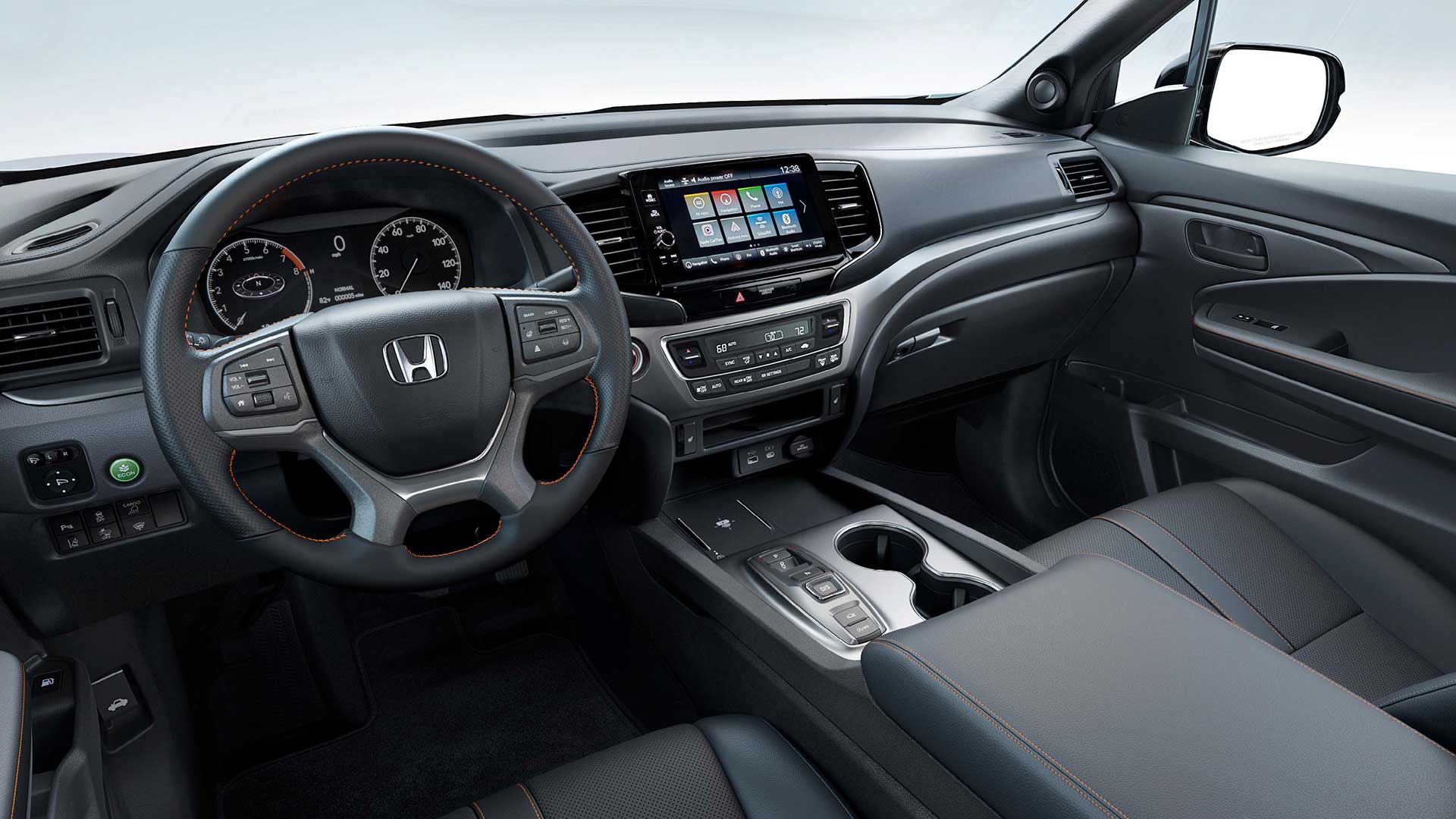
The revised suspension and knobbier tires didn’t really seem to add or detract from handling prowess, as it felt as solid, nimble, and car-like as it always has through our cone course. Perhaps a little less stiff than before, but good feedback, tight steering, and minimal body roll for a pickup, made for a very confidence inspiring experience. In our braking test, we stopped in a respectable average of 123 feet from 60, with only moderate amounts of nosedive and good feel through the pedal.
There is, however, a slight reduction in Government Fuel Economy Ratings with the all-terrain tires; 18-City, 23-Highway, and 20-Combined, our average, right on, at 20.4 mpg of Regular. That’s a slightly below average Energy Impact Score of 14.9 barrels of yearly oil use, with CO2 emissions of 7.4 tons.
TrailSport pricing falls in line just under the Ridgeline’s top Black Edition trim with a starting price of $46,375, about five grand over a base Ridgeline Sport.
So, whether you consider the Honda Ridgeline to be a “real” truck or not, this ruggedly smooth 2024 TrailSport does truck-like things better than ever. And we’re not just talking about the slight upgrade in off-road performance, we’re talking about a flexible bed to help you get chores done, and the ability to tow or haul with comfort and flexibility other trucks can only wish for. It’s why the Ridgeline brings more first-time buyers to Honda than any other vehicle, and why it continues to be a great choice in the growing midsize truck realm.
Specifications
- Engine: 3.5-liter V6
- Transmission: 9-speed automatic
- Horsepower: 280
- Torque: 262 lb-ft
- EPA: 18 City | 23 Highway | 20 Combined
- 0-60 mph: 7.0 seconds
- 1/4 Mile: 15.5 seconds at 90 mph
- 60-0 Braking (avg): 123 feet
- MW Fuel Economy: 20.4 mpg (Regular)
- Max Towing Capacity: 5,000-lbs








